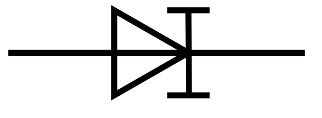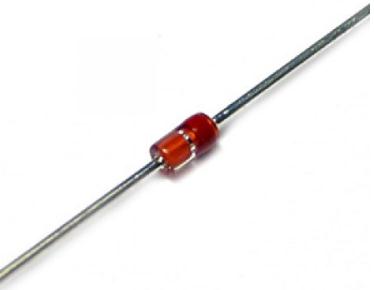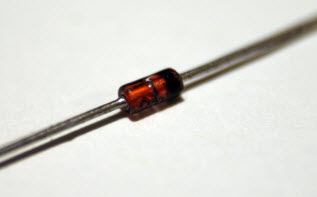Definition: A diode is an electronic component that allows the flow of current in only one direction and when the current flows in the other direction, then it blocks the current. The name diode is derived from the word “di-ode” which means that a device having two electrodes. Thus, a diode has two electrodes one electrode is known as the anode and the other electrodes are known as the cathode.
The diode is a semiconductor device, which is usually made from silicon, germanium, or selenium, that is classed as intrinsic semiconductors. Diodes are widely used as a rectifier, signal modulators, signal demodulators, voltage regulators, signal mixers, signal modulators, signal limiters etc.
The fundamental Diodes allow current to flow in only one direction and also change the electrical current from alternating current (AC) to direct current (DC), the process of conversion is known as rectification. The diode will start operating only when a voltage is applied across its terminals. The ‘ON’ state of a diode is achieved when the positive point is applied to the anode and negative point is applied to the cathode or you can say that the ‘ON’ state of a diode has current is in the direction of the arrowhead. This procedure is known as ‘Forward biasing’. Similarly, the ‘OFF’ state of a diode is achieved when the lower potential is applied to the anode and higher potential is applied to the cathode or you can say that the ‘OFF’ state of a diode have current in the opposite direction of the arrowhead. This procedure is known as ‘Reverse biasing’.

We’ll be covering the following topics in this tutorial:
Types of Diode
There are many types of diode that are available which are listed as follows:
Backward Diode
It is also known as a back diode. It is least used diode. The process of the backward diode is similar to the tunnel diode. It can be used in some applications where it is needed.

Gunn Diode
It is a PN Junction diode and it is similar to the semiconductor device which has two terminals. It is also known as Transferred Electronic Device. This diode is used to generate microwaves.
Laser Diode
It does not resemble with the ordinary LED (Light Emitting Diode) as it generates coherent light. This type of diode is used in many applications like CD drives, DVD drives etc. Also, these diodes are less costly as compared to other diodes.
Photo Diode
This type of diode is used to detect light. It can also be used to produce electricity. Generally, these types of diodes used to operate under reverse bias condition.
Pin Diode
This type of diode is one of the types of the photodetector which is used to convert the optical signal into an electrical signal. This diode consists of three regions-
P-region, I-region, and N-region, whereas both P and N-region are heavily mixed with impurities and the I-region have no mixed impurity.

PN Junction Diode
This type of diode is in use nowadays. The PN junction diode is a two-terminal device. This type of diode is formed when one side of the PN junction diode is made up of p-type and is mixed with the n-type material. PN junction diode is used in low current applications.
BARITT Diode
The full form of BARITT is Barrier Injection Transmit Time diode. This type of diode is used for the generation of the microwave signal, burglar alarm etc.
Light Emitting Diodes
The short form of the Light emitting diode is LED which is most commonly used. These LEDs contain a semiconductor chip and LEDs can produce many colors, but the most common color is red.
Zener Diode
Zener diode operates in reverse bias condition i.e. when a particular voltage is reached, then the circuit gets to break down. This type of diode is used to provide a stable reference voltage. Generally, this type of diode is used to provide a reference voltage during the supply of the power.

Tunnel Diode
It is not most commonly used. A tunnel diode is also called as Esaki diode as it is invented by Leo Esaki. It is mainly used in the microwave applications. Tunnel diode can also be used as an amplifier, oscillators and in any switching circuits.
Step Recovery Diode
This type of diode is used to generate at the very high frequency.
Schottky Diode
This type of diode is designed in a different way as compared to other diodes. Also, Schottky diodes have a lower forward voltage drop. Generally, they are used as clamping diodes.
Varactor Diode
This type of diode is also known as varicap diodes and it is mainly used in radio frequency applications. Varactor diodes are designed in such a way that they permit a high range of changes in capacitance.
Applications of Diode
• The diode is used in the rectifier.
(Rectification is the process of converting AC (Alternating Current) into DC (Direct Current).
• Diodes are used in clipper circuit.
(Clippers are the networks in which we make use of diodes to “clip” away a portion of an input signal without affecting the other part of the applied waveform)
• Diodes are used in clamper circuit.
(A clamper is a network which is made up of a diode, a resistor, and a capacitor. It shifts the waveform to an another DC level without affecting the applied signal.)
• Laser diodes are used in medical treatment like cancer detection, DNA analysis, blood analysis, X-ray film marking etc…
• LEDs are used in household appliances, switches, security equipment, mobile phones, Digital cameras, laptops etc.
Advantages of using a Diode
• It is more suitable for pulsed operation.
• There is very low power dissipation for diodes.
• Their efficiency is high.
• They allow the flow of current in only one direction.
• An ideal diode has zero resistance in the forward direction and infinite resistance in the opposite direction.
• They are small and compact.
• They are more reliable.
 Dinesh Thakur holds an B.C.A, MCDBA, MCSD certifications. Dinesh authors the hugely popular
Dinesh Thakur holds an B.C.A, MCDBA, MCSD certifications. Dinesh authors the hugely popular